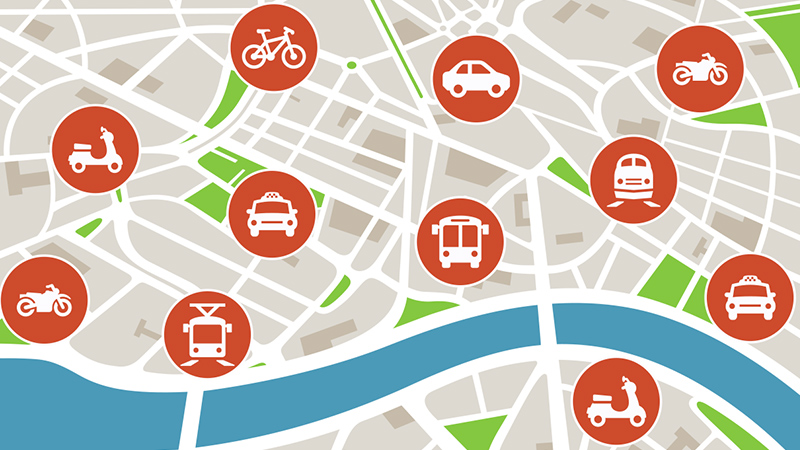What would it take for you to give up your car? Excellent bus and rail services perhaps? How about combining these types of public transportation with on-demand electric bikes and scooters to cover that first and last mile of your commute, as well as taxis and ridesharing services?
Still sound like too much work? Then what if routes were planned for you, so you didn’t have to think about how to get from A to B? And for those times when you really want a car — a friend visiting from out of town, for example, or a hot date — what if you could choose from a range of new dream cars, one of which could be delivered to your doorstep for the occasion? Still not convinced? Here’s my final offer: What if you could have all these options and more, available from a single smartphone app for a fixed monthly subscription?
See also: Autonomous trucks to deliver packages
Welcome to Mobility-as-a-Service (MaaS), an emerging transportation paradigm which aims to lure people away from their cars by offering freedom of mobility without the hassles of car ownership. MaaS offers a smorgasbord of services through an app — from various modes of transport through trip planning, booking, ticketing and payment. That’s why it’s been called the “Netflix of urban transport.”
“Even in the U.S., there’s a growing number of young urban people who view car ownership as a bit of a drag,” says Sampo Hietanen, the father of mobility-as-a-service and CEO of MaaS Global.“What they really value is the ability to go anywhere on a whim.”
Mobility on a Whim
Hietanen’s “whim” reference is no casual word choice; his company provides a MaaS service called Whim in its home market of Helsinki. It recently launched the service to Antwerp, Belgium and Birmingham, England, and plans to expand in cities across Europe, the U.S. and Asia later in 2019, the company says.
Whim users in Helsinki can choose from three service plans— an unlimited plan for 499 Euro per month (about US$550), a limited plan for 62 Euro per month (nearly US$70) and a pay-as-you-go plan. At last count, Whim’s roughly 45,000 users in Helsinki had made more than 4 million trips. More than 5,000 of those users pay monthly fees.
MaaS Global is the leading MaaS company in an increasingly crowded field. Other players include the MaaS Alliance, a public-private partnership focused on creating the foundation for a common approach to MaaS and involved in projects worldwide; and companies like CityMapper, which is live in 39 cities from Montreal to London to Sao Paulo. Los Angeles recently partnered with Xerox to pilot a MaaS app named GoLA that allowed users to pick routes based on whether they’re faster, cheaper or greener. Cisco, too, is researching MaaS.
“MaaS is really about right-sizing your transportation needs,” says Ashley Hand, co-founder of Cityfi, which is helping cities like Los Angeles make the transition to digital transportation technologies including MaaS.
The Thrill is Gone
MaaS proponents are part of a growing chorus of mobility pioneers who proclaim the end of people’s love affair with the automobile is near — at least in cities. After all, they reason, cars are expensive, one-ton polluting machines that sit unoccupied on average 96 percent of the time.
Even though millennials’ relationship with cars may be more nuanced than thought, driving in cities is not getting any easier. Most commuters travel solo and, as more people crowd into cities, travel times take longer and longer. Even Ford — the company that gave us the first affordable automobile more than a century ago — is looking beyond car ownership, towards MaaS.
“This idea that car ownership equals freedom is outdated thinking,” Hand says. “Mobility is freedom and the mode doesn’t matter.”
Hubs vs. Highways
The traditional response to the challenges of clogged city streets has been to increase supply — by building new roads, upgrading rail lines and running more services, for example. MaaS offers an alternative solution.
But Hietanen says large-scale adoption of MaaS faces challenges of its own. For example, many entrenched private transportation players tend to want to dominate the MaaS platform, versus collaborating with rivals through an open API approach.
See also: Getting around LA for 2028 Olympic Games goes futuristic
On the technical side, many transportation systems are not mobile capable or API capable. For example, users of Barcelona’s metro underground system use cards to open gates — a system that doesn’t lend itself to a mobile app. And the payment industry tends to use an old-fashioned platform model, Hietanen says.
Perhaps the greatest challenge facing MaaS is the way cities have evolved around the automobile, with webs upon webs of highways and lanes. For Hietanen, a mature expression of MaaS would require a shift away from lanes to hubs. These hubs would be strategically placed — and beautiful — nerve centers where people could switch between different modes of transport.
“MaaS doesn’t just change the demand for a different approach to mobility; it also changes the infrastructure based on that demand,”Hietanensays. “Most cities are not hub-based and are not equipped for this change.”
The Driverless Turning Point
Despite these challenges, MaaS appears headed for a bright future. According to ABI Research, MaaS will be a trillion-dollar market by 2030.
A key catalyst in the MaaS revolution, ABI says, will be the rise of driverless technology, or Car-as-a-Service (CaaS). This will undercut the cost of car ownership and spur development of the MaaS ecosystem by removing the need for paid drivers, cutting insurance costs, increase vehicle usage rates and other efficiencies.
Autonomous vehicles (AVs) will also usher in the rise of fleets of cars that users will share — much as we share Uber and Lyft vehicles today, Hietanen adds.
“When AVs hit roads, that’s when the ownership model dies,” he says.




